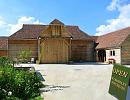Antiques for Sale | Antique Furniture | Antique Fairs | Antiques Listings | Antiques Email Alerts | Websites for Antique Dealers | Contact

Webberley Antiques
Proprietor: Mrs. Deborah Tice
Tel :01424 838557 International 0044 1424 838557
Email : webberley@btconnect.com
Web : www.webberley.co.uk
Web : www.antiques-atlas.com/webberleyantiques/
The Barn
Battle Road, Dallington
East Sussex, TN21 9LQ
Open: We open by arrangement only, please ring first with all enquiries.
Cocus Wood Oyster Veneer English Scriptor c. 1675



Description
This extraordinary piece has come from a private vendor and it is remarkably original in all aspects. It dates from c. 1675Small and beautifully proportioned it is extremely rare to find a piece of English furniture of this date that is so complete and original. The whole is dressed in oyster cut veneers of Cocus Wood – an expensive and exotic timber prized for its contrasting dark heartwood and prominent pale sapwood.
The outer face of the fall is beautifully inlaid with an architectural three bay window of matched figured walnut outlined with holly and this is centred with a band of ebony. The architectural window motif is repeated to both side panels.
The slender upper curved secret drawer, double ogee cornice and double ogee waste mouldings are dressed with thickly cut and shaped cocus wood veneers, the wood cut with the grain to produce a stunning ribbon effect. The lower more simply shaped borders are original also and separate the principal drawers from lowest drawer giving symmetry and consistent width.
The original tall bun feet are constructed in shaped sections as is correct for the period and have old worm, chips, marks and significant wear to the bases as is expected over hundreds of years of use.
The interior finely crafted and with multiple secret drawers – each of the pigeon holes along the top pulls forward to reveal a secret double drawer. Again all drawers with wainscot oak linings. A small brass pen rest in a divided drawer on the lower left appears original also. The inner fall inset with a thickly cut leather skiver with gold tooling – attractively aged with some old marks and wear.
Minor marks, some old worm and small restorations. I believe a couple of the timbers at the back and in the very base of the rear carcase may be later replacements for once original wormed sections but these replacements are very old indeed, minimal and professionally done.
In the post restoration period from the 1660s the skill of English cabinet makers was unsurpassed and World renowned. And this must have been a very important piece of furntiure in its day, or certainly made for an important person. Cocus wood was imported from Jamaica in large quantities from the 1660s and was frequently used by English cabinet-makers of the period both in the solid and as veneers. The colour, cut and quality of the oysters on this scriptor are superb, each beautifully cut and matched so that there is a sense of flow and movement – it has great charm and character. After 1680 oyster veneers were more usually cut from Olive wood – a much cheaper wood for the cabinet makers to buy and which in the late 17th century was being imported in great quantities from the Mediterranean.
The principal graduated drawers retain their original full oak linings and open and close smoothly. All handles and escutcheons appear original also. Very fine hand cast and fettled pierced brass with small faces amongst the filigree.
Beautifully proportioned and demonstrating wonderful skills in the making, it is hard to believe that such a piece can be found outside of a museum. Fantastic colour, patination and of spectacular quality - and a truly superb early English scriptor.
The scriptor separates into two sections for transport.
Dimensions are:
65.75 inches high
38.5 inches wide
20 inches deep
The upper secret drawer has a height of 2 inches
The upper main drawer is 6 inches
The second 7.25 inches
The lowest inset drawer is 3.5 inches.
The feet are 8 inches tall
For metric please multiply by 2.5
I describe and photograph my pieces accurately and with the aim that on arrival each will exceed expectations.
I operate a full refund guarantee and am always happy to give free, honest and friendly advice.
DateRestoration :
c.1675
Codeas216a2155
Price SOLD £12000.00
StatusSold
SellerWebberley Antiques
Telephone01424 838557Non UK callers :+44 1424 838557 Emailwebberley@btconnect.com
Contact
Send Webberley Antiques a message about this item here





